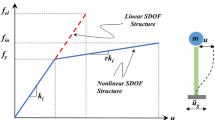Abstract
The present paper explores the use of Artificial Neural Networks (ANN) to predict storey displacement in multi-storey reinforced concrete buildings by analysing structural parameters that significantly influence storey displacement. The present adopted technique for non-linear dynamic analysis is time- and resource-consuming and requires high technical skills for accurate results for multi-storey buildings. Therefore, the present study focuses on establishing correlations between structural parameters and storey displacement to enable fast-track estimation of seismic responses. Modal response spectrum analysis is used to simulate earthquake loading and produce storey displacement data for training the neural networks. Furthermore, varying data sizes of training and testing data are utilized for develo** high-performing machine learning models and the best-performing model is identified. The results indicate that ANN with 60% data in training and 40% in testing has the best accuracy of 99% in both training and testing phases. The study's findings can aid in earthquake vulnerability assessment, understanding building conditions due to earthquake loads, and recommending building maintenance accordingly. Additionally, the results can act as a preliminary analysis for earthquake loadings allowing designers to proceed with the detailed structural design based on acceptable storey displacement results.





















Similar content being viewed by others
Data availability
The data and supplementary material are available on request.
References
Adeli, H. (2001). Neural networks in civil engineering: 19892000. Computer-Aided Civil Infrastructure Eng, 16, 12642.
Adeli, H., & Yeh, C. (1989). Perceptron Learning in Engineering Design. Computer Civil Infrastructure Engineering. https://doi.org/10.1111/j.1467-8667.1989.tb00026.x
Araya, R., & Saragoni, G. R. (1984). Earthquake accelerogram destructiveness potential factor. Proceedings of the Eighth World Conference on Earthquake Engineering San Francisco, 2, 835–842.
Back, T. (1997). Evolutionary computation: Toward a new philosophy of machine intelligence. Complexity, 2, 28–30. https://doi.org/10.1002/(SICI)1099-0526(199703/04)2:428:AID-CPLX73.0.CO;2-2
de Lautour, O. R., & Omenzetter, P. (2009). Prediction of seismic-induced structural damage using artificial neural networks. Engineering Structures. https://doi.org/10.1016/j.engstruct.2008.11.010
Gandomi, A. H., & Alavi, A. H. (2013). A new methodology for predicting compressive strength of recycled aggregate concrete using multilinear regression analysis. Journal of Cleaner Production, 52, 262–277. https://doi.org/10.1016/j.jclepro.2013.03.031
Ghani, S., & Kumari, S. (2023). Prediction of soil liquefaction for railway embankment resting on fine soil deposits using enhanced machine learning techniques. Journal of Earth System Science, 132(3), 1–23.
Ghani, S., Kumari, S., Jaiswal, S., & Sawant, V. A. (2022). Comparative and parametric study of AI-based models for risk assessment against soil liquefaction for high-intensity earthquakes. Arabian Journal of Geosciences, 15(14), 1262.
Huang, C. S., Hung, S. L., Wen, C. M., & Tu, T. T. (2003). A neural network approach for structural identification and diagnosis of a building from seismic response data. Earthquake Engineering and Structural Dynamics, 5, 75–88.
Kanwar, V. S., Singh, R. P., Kwatra, N., & Aggarwal, P. (2014). Monitoring of RCC structures affected by earthquakes. Geomatics, Natural Hazards, and Risk. https://doi.org/10.1080/19475705.2013.866984
Kaveh, A., Dadras, E. A., Javadi, S. M., & Geran, M. N. (2021). Machine learning regression approaches for predicting the ultimate buckling load of variable-stiffness composite cylinders. Acta Mechanica, 232, 921–931.
Kaveh, A., Gholipour, Y., & Rahami, H. (2008). Optimal design of transmission towers using genetic algorithm and neural networks. International Journal of Space Structures, 23(1), 1–19.
Kaveh, A., Izadifard, R. A., & Mottaghi, L. (2020). Optimal design of planar RC frames considering CO2 emissions using ECBO, EVPS and PSO metaheuristic algorithms. Journal of Building Engineering, 28, 101014.
Kaveh, A., Kalateh-Ahani, M., & Fahimi-Farzam, M. (2013). Constructability optimal design of reinforced concrete retaining walls using a multi-objective genetic algorithm. Structural Engineering and Mechanics, 47(2), 227–245.
Kaveh, A., & Nasrollahi, A. (2014). Performance-based seismic design of steel frames utilizing charged system search optimization. Applied Soft Computing, 22, 213–221.
Kazemi, F., Mohebi, B., & Yakhchalian, M. (2018). Enhancing the seismic performance of adjacent pounding structures using viscous dampers. In: The 16th European Conference on earthquake engineering (16ECEE), 18–21, June, Thessaloniki, Greece.
Kazemi, F., Asgarkhani, N., Manguri, A., & Jankowski, R. (2022). In investigating an optimal computational strategy to retrofit buildings with implementing viscous dampers (pp. 184–191). Springer.
Kiani, J., Camp, C., & Pezeshk, S. (2019). On the application of machine learning techniques to derive seismic fragility curves. Computers and Structures. https://doi.org/10.1016/j.compstruc.2019.03.004
Kicinger, R., Arciszewski, T., & De Jong, K. (2005). Evolutionary computation and structural design: A survey of the state-of-the-art. Computers and Structures, 83(23–24), 1943–1978.
Kim, Y. S., & Park, H. S. (2016). Flexural strength prediction of steel-reinforced concrete beams with different reinforcement configurations using multilinear regression analysis. Journal of Computing in Civil Engineering, 30(2), 04015011. https://doi.org/10.1061/(ASCE)CP.1943-5487.0000503
Lagaros, N. D., & Fragiadakis, M. (2007). Fragility assessment of steel frames using neural networks. Earthquake Spectral, 23, 735–752.
Lagaros, N. D., Tsompanakis, Y., Psarropoulos, P. N., & Georgopoulos, E. C. (2009). Computationally efficient seismic fragility analysis of geostructures. Computers and Structures, 87(19–20), 1195–1203.
Liao, T. W., Egbelu, P. J., Sarker, B. R., & Leu, S. S. (2011). Metaheuristics for project and construction management—A state-of-the-art review. Automation in Construction, 20(5), 491–505.
Lippmann, R. P. (1987). An Introduction to Computing with Neural Nets. IEEE ASSP Magazine. https://doi.org/10.1109/MASSP.1987.1165576
Modha, D. S., Ananthanarayanan, R., Esser, S. K., Ndirango, A., Sherbondy, A. J., & Singh, R. (2011). Cognitive computing. Communication ACM, 54, 62–71.
Mohebi, B., Kazemi, F., & Yakhchalian, M. (2018). Investigating the P-delta effects on the seismic collapse capacity of adjacent structures. In: 16th European Conference on earthquake engineering (16ECEE), 18–21, June, Thessaloniki, Greece.
Molas, G. L., & Yamazaki, F. (1995). Neural networks for quick earthquake damage estimation. Earthquake Eng Struct Dyn. https://doi.org/10.1002/eqe.4290240404
Nakamura, M., Masri, S. F., Chassiakos, A. G., & Caughey, A. K. (1998). A method for nonparametric damage detection through the use of neural networks. Earthquake Eng Struct Dynamic, 27, 9971010.
Nakane, H., Kodama, E., & Yokoi, I. (1992). New earthquake-induced ground motion severity sensing apparatus for reliable system shutdown. Proceedings of the Tenth World Conference on Earthquake Engineering in Madrid, 9, 5559–5562.
Nekomoto, Y., Fujita, K., & Tanaka, M. (1991). Simulation on the active vibration control of structures by neural networks. Proceedings of symposium on application of fuzzy and neural networks (pp. 93–96). JSME. in Japanese.
Nguyen, H. D., Dao, N. D., & Shin, M. (2021). Prediction of seismic drift responses of planar steel moment frames using artificial neural network and extreme gradient boosting. Engineering Structures, 242, 112518.
Noor, A. K. (2014). Potential of cognitive computing and cognitive systems. Open Engineering, 27(5), 1.
Noureldin, M., Ali, A., Sim, S., & Kim, J. (2022). A machine learning procedure for seismic qualitative assessment and design of structures considering safety and serviceability. Journal of Building Engineering, 50, 104190.
Park, Y. J., Ang, A. H., & Wen, Y. W. (1985). Seismic damage analysis of reinforced concrete buildings. Journal of Structural Engineering, 111, 740–757.
Rajasekaran, S., & Pai, G. A. V. (2007). Neural network, fuzzy logic, and genetic algorithms synthesis and applications. Prentice Hall of India.
Rofooei, F. R., Kaveh, A., & Masteri, F. F. (2011). Estimating the vulnerability of concrete moment resisting frame structures using artificial neural networks. International Journal of Operational Research, 1(3), 433–448.
Russell, S. J., Norvig, P., Canny, J. F., Malik, J. M., & Edwards, D. D. (2003). Artificial intelligence. A modern approach (2nd ed.). Prentice Hall.
Sahoo, D. M., Das, A., & Chakraverty, S. (2014). Interval data-based system identification of multistorey shear buildings by artificial neural network modeling. Architectural Science Review. https://doi.org/10.1080/00038628.2013.841091
Saka, M. P., & Geem, Z. W. (2013). Mathematical and metaheuristic applications in design optimization of steel frame structures: An extensive review. Mathematical Problems in Engineering, 2013, 271031.
Samuel, A. L. (1959). Some studies in machine learning using the game of checkers. IBM Journal of Research and Development, 3(3), 535–554.
Sharma, V. K., & Pandey, R. K. (2017). Prediction of shear strength of reinforced concrete beams using multilinear regression analysis. Journal of Performance of Constructed Facilities, 31(6), 04017072. https://doi.org/10.1061/(ASCE)CF.1943-5509.0001056
Stephens, J. E., & Van Luchene, R. D. (1994). Integrated assessment of seismic damage in structures. Computer Civil Infrastructure Eng. https://doi.org/10.1111/j.1467-8667.1994.tb00367.x
Sun, H., Burton, H. V., & Huang, H. (2021). Machine learning applications for building structural design and performance assessment: A state-of-the-art review. Journal of Building Engineering, 33, 101816.
Thandavamoorthy, T. S., Muthukumaran, K., & Muthukumaran, M. (2017). Multilinear regression analysis for optimization of a steel roof truss. International Journal of Engineering Research and Technology, 6(3), 437–442. https://doi.org/10.17577/IJERTV6IS030313
Thapa, I., & Ghani, S. (2023). Estimation of California bearing ratio for hill highways using advanced hybrid artificial neural network algorithms. Multiscale and Multidisciplinary Modeling, Experiments and Design. https://doi.org/10.1080/19475705.2013.866984
Tung, T. Y., Wong, F. S., & Dong, W. (1994). Prediction of the spatial distribution of the Modified Mercalli Intensity using neural networks. Earthquake Engineering Structural Dynamics, 23, 49–62.
Vafaei, M., Adnan, A. B., & Abd Rahman, A. B. (2012). Real-time seismic damage detection of concrete shear walls using artificial neural networks. Journal of Earthquake Engineering, 17(1), 137–215. https://doi.org/10.1080/13632469.2012.713559
Wang, Z., Pedroni, N., Zentner, I., & Zio, E. (2018). Seismic fragility analysis with artificial neural networks: Application to nuclear power plant equipment. Engineering Structures, 1(162), 213–225.
Worden, K., & Green, P. L. (2016). A machine learning approach to nonlinear modal analysis. Mechanical Systems and Signal Processing. https://doi.org/10.1016/j.ymssp.2016.04.029
Wu, X., Ghaboussi, J., & Garrett, J. H. (1992). Use of neural networks in the detection of structural damage. Computer Structure, 42, 64959.
**e, Y., Ebad Sichani, M., Padgett, J. E., & DesRoches, R. (2020). The promise of implementing machine learning in earthquake engineering: A state-of-the-art review. Earthquake Spectra, 36(4), 1769–1801.
Zhu, T. J., Heidebrecht, A. C., & Tso, W. K. (1988). Effect of peak ground acceleration to velocity ratio on ductility demand of inelastic systems. Earthquake Engineering and Structural Dynamics, 16, 63–79.
Funding
No funding was obtained for this study.
Author information
Authors and Affiliations
Contributions
NS: analysis, results compilation, and writing the first draft, machine learning application, and interpretation of ml results. MG: conceptualization, data collection, processing of results, and writing the first draft. SG: conceptualization, machine learning application, and interpretation of ml results, finalizing the draft. SK: reviewing, and drafting the final manuscript.
Corresponding author
Ethics declarations
Conflict of interest
On behalf of all authors, the corresponding author states that there is no conflict of interest.
Ethical approval
Not applicable.
Additional information
Publisher's Note
Springer Nature remains neutral with regard to jurisdictional claims in published maps and institutional affiliations.
Rights and permissions
Springer Nature or its licensor (e.g. a society or other partner) holds exclusive rights to this article under a publishing agreement with the author(s) or other rightsholder(s); author self-archiving of the accepted manuscript version of this article is solely governed by the terms of such publishing agreement and applicable law.
About this article
Cite this article
Shrestha, N., Gupta, M., Ghani, S. et al. Enhancing seismic vulnerability assessment: a neural network effort for efficient prediction of multi-storey reinforced concrete building displacement. Asian J Civ Eng 25, 2843–2865 (2024). https://doi.org/10.1007/s42107-023-00949-y
Received:
Accepted:
Published:
Issue Date:
DOI: https://doi.org/10.1007/s42107-023-00949-y




